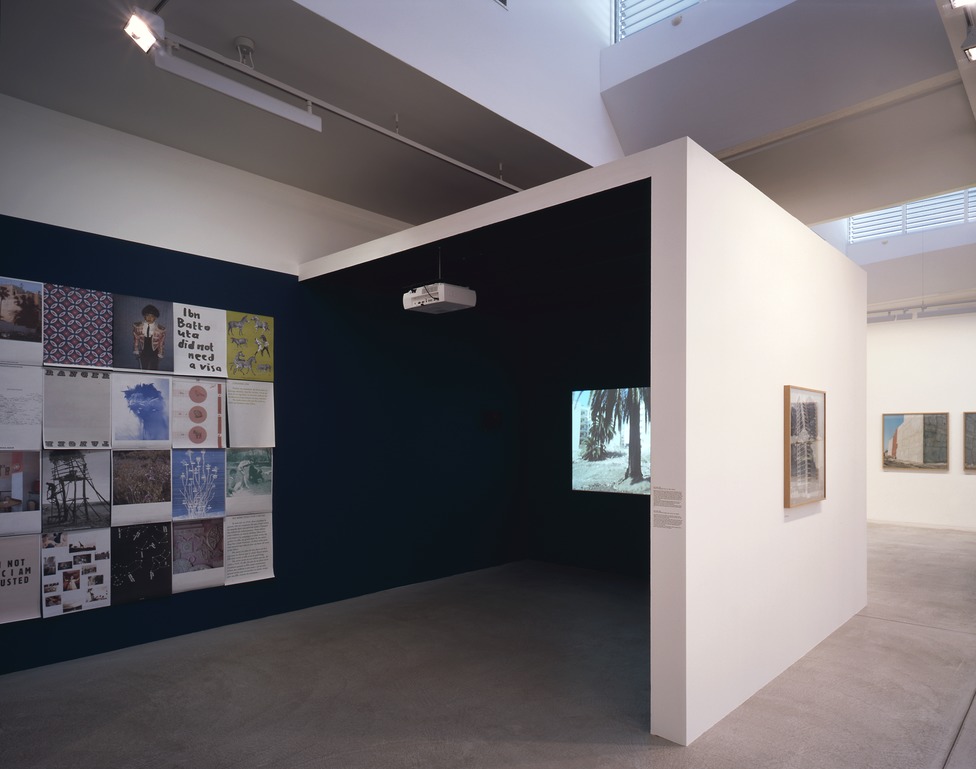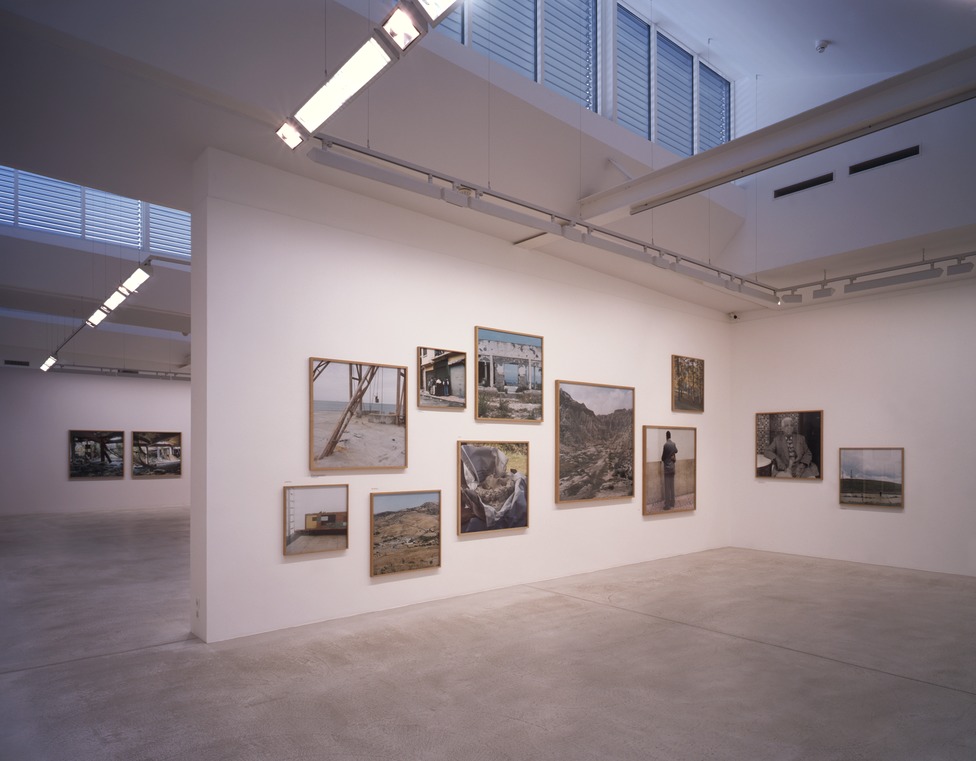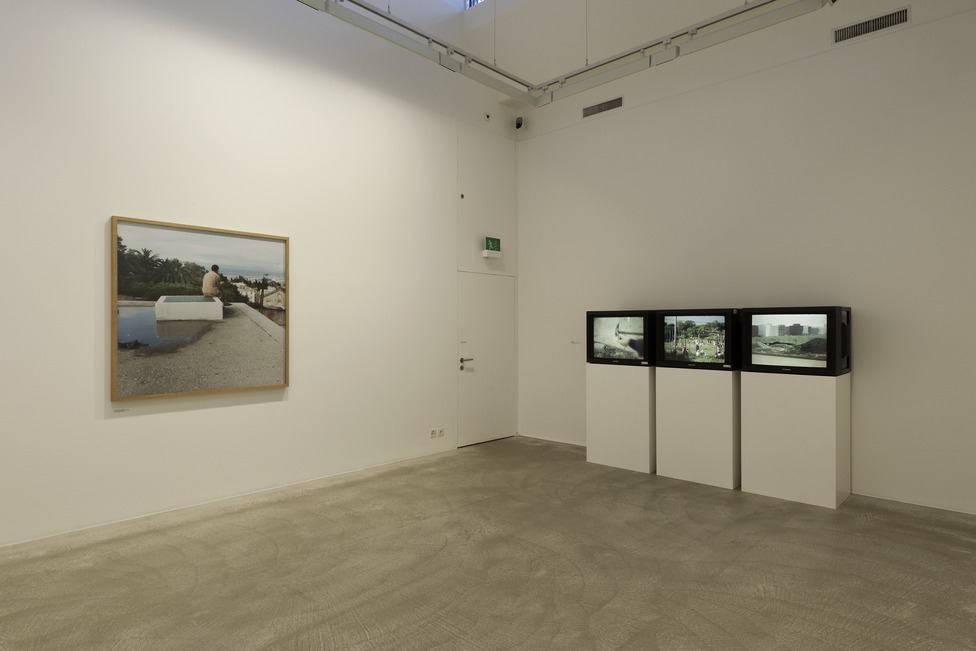“If you see her, say ‘hello,’ she might be in Tangier,” Bob sings on his LP Blood on the Tracks. “She left here last early spring, is living there I hear.” A few riffs later he adds, “We had a falling-out, like lovers often will/And to think of how she left that night, it still brings me a chill.” Northern Europeans and Americans have long projected their nostalgic yearnings onto the city of Tangier, most especially since the 1950s, with the likes of Paul and Jane Bowles, Tennessee Williams, Jack Kerouac, Truman Capote, William S. Burroughs, and, a few decades later, Bob Dylan eulogizing it as a place of melancholy escape. Tangier is both home and subject of research for Moroccan-French artist Yto Barrada, born in Paris in 1971 and raised in both countries. But hers is not the Tangier of existential seekers nor of the ten million tourists who annually descend on Morocco to gratify their Orientalist fantasies. Her Tangier is the city of the 1990s and the first decade of this millennium; her preoccupation is the city of today, to which she devotes almost every single work—video, photograph, sculpture, and installation—forever addressing the city in new variations. There are other artists, but not many, who have such an intense relationship with a single city: David Goldblatt and Johannesburg (although his research really extends to all of South Africa); William Eggleston and Memphis, Tennessee.
The Schengen Agreements—I (1985), II (1990/1995), and III (2005)—have refashioned the map of a consolidated Europe, radically reformulating the realities and rights inside and outside that territory—much like the inner boundaries that collapsed when Switzerland was established as a state in 1848, while the outer ones were drawn much closer, cutting off the ancestral routes of non-sedentary peoples. The Strait of Gibraltar, a mere nine miles wide, has been an insurmountable obstacle, a Mariana Trench between Europe and Africa, since 1991. It is a thirty-five-minute journey for speedboats with hordes of tourists traversing the Strait from north to south, while Moroccans (and Africans in general) traveling in the opposite direction are seized by the police and instantly deported. The Strait has become a one-way tourist street, where the exchange of cultures once lent wings to the imagination. This is the substance of the series “A Life Full of Holes: The Strait Project” (1998–2004), in which Barrada investigates the cut, the surgical intervention in physical trade routes and mental escape routes. Travel to Europe was once an interesting possibility, not an absolute must, but the severance of northern Africa has resulted in a desperate longing for escape. In quietly observant, unobtrusive images, Barrada’s series generates a climate of waiting, persevering, circling: chunks of concrete bearing mute witness to a tunnel between Europe and Africa that was never built; a wall with imprints of a football kicked against it over and over again, possibly out of boredom; boys crawling onto a football pitch through a hole in a cyclone fence; a young man sitting and waiting in front of a closed store. The feeling of being confined—as in the view through an eternally revolving Ferris wheel of the expanses beyond—are broken by isolated thrusts of energy and aggression. Those daring enough to undertake the expensive and dangerous journey to “paradise” in a small boat burn everything before embarking. Everything. They burn their papers to obscure their origins, leaving only ashes behind. We know only the numbers of those who have been apprehended; darkness reigns over the numbers of those who have drowned or have successfully made it across without detection.
The people Barrada has photographed here and in other pictures are seen in surroundings and situations that look as if they had been choreographed and staged, as if the subjects had been instructed to take a certain attitude: crouching down to peer through a hole in the wall, bending over while sitting on a beach towel on a meadow, gazing back sideways to get a glimpse of a cage, casually sitting hunched on a wall, resting on a bench, or sleeping in a park. Their bodies are often slightly contorted, off-balance. They don't look at us—they turn their backs as if escaping, at least metaphorically, or in an effort to show detachment from us, from themselves, and from the history and politics of their country, while at the same time running aground on the rock of Gibraltar. As Barrada has explained, “When you spend your time on the edge, on the jumping-off place of Africa, trying to get on the other side, you’re as a consequence turning your back on whatever’s happening where you are, so you’re not invested in what you’re doing for your own country.”1) She goes still further: “There is no pleasure in these pictures. They show violence—a muted, lingering violence that has become much more tangible since the borders were closed. But why doesn’t this violence explode? It is deceptive, like a prerevolutionary situation that is constantly at the boiling point without boiling over.”2) These emotions finally erupted in the Arab Spring, although the outcome in Morocco has so far been less dramatic than in neighboring countries.
The border with Europe is not the only one that affects the residents of Tangier. Borders divide the interior of the city as well, as it rapidly mushrooms into a conventional real-estate paradise. According to Barrada, five thousand building permits were issued in 2009. The city is spilling over into the landscape to the south, and in the center, buildings are shooting up on every available plot of unoccupied land; everything that is unclear, all the terrain vague, is being appropriated by new buildings and scattered settlements. Real-estate capitalism paired with neoliberal politics has acquired a foothold, carving a path through the existing architecture and established forms of landownership. Barrada’s photographs show the excavation, the rampant growth, the unbridled development, the possessive thrust of new buildings. Her video BEAU GESTE (2009) shows three men taking care of a fragile palm tree. Hired by Barrada, the activists work illegally, making use of a law that forbids landowners to build on or sell their land if anything is growing on it. The action, a form of “guerrilla gardening,” provokes intense debate among people walking by.
Another, equally absurd law stipulates that people can import only as much as they can carry on their person from Ceuta, a Spanish exclave in Morocco, into Morocco itself. Barrada visualizes this trade restriction in a photograph showing mountains of empty brown cardboard boxes that line a steep, dusty staircase to nowhere. Before passing through customs, everyone discards the packaging in order to tuck the goods away deep inside their clothing, like the woman in Barrada’s video LA CONTREBANDIèRE (The Smuggler, 2006). Before our eyes, she peels off layer after layer after layer of clothing, in which she has buried fabrics of different sorts.
Barrada keeps an Argus-eyed watch on the changes in Tangier, exposing and challenging them in her actions, photographs, and films. Interestingly, her images are always conspicuously calm, her observation of events detached and dispassionate. They are neither iconic nor belligerent; they have no intention of functioning as weapons of enlightenment. This is not a self-assured, overbearing visual universe that knows exactly how to behave and takes full advantage of its impact. Okwui Enwezor has commented on how well the images fend off any vampiric appropriation of the media.3) In these square, unspectacular, almost static color photographs, it is as if Barrada were retreating, taking two or three steps backward, to make room for views of a landscape, an urban situation, or a human presence that is simply there, quiescent. The things, buildings, and people are an imperative, commanding our attention and compelling us to commit, seek, explore, and think. The signs we see are conspicuously understated: a gesture, a circumstance, real and allegorical at once. In his novel Midnight’s Children (1980), Salman Rushdie describes a character who views a woman through a perforated sheet, an extremely fragmented encounter that he then attempts to assemble into a mysterious whole in his mind. The effect of Barrada’s photographs is similar. These are fragments of a language of orientation, paralysis, pain, fragile resistance, a declaration of love for a city that signifies home, politics, commodities, trade—and life. The artist’s pictures dawdle and dally as if they had all the time in the world, only to spin a web of illusions and information. All the irises and palm trees gradually coalesce into a political, economic, and emotional fabric of meaning.
And hope? It becomes manifest in TECTONIC PLATE (2010), a wooden relief where continents can be shifted, aligned, and united by hand, where utopias slowly become reality. But as we all know, (political) tectonic shifts take time.
1) Yto Barrada, in Yto Barrada and Charlotte Collins, “Morocco unbound: an interview with Yto Barrada” (May 17, 2006), http://www.opendemocracy.net/arts-photography/barrada_3551.jsp (accessed October 5, 2012).
2) Yto Barrada, in “Barrada in Conversation with Nadia Tazi,” A Life Full of Holes: The Strait Project (London: Autograph ABP, 2005), p. 59.
3) Okwui Enwezor in Riffs (Ostfildern: Hatje Cantz, 2011), p. 25.
Published in "Parkett", 2012



